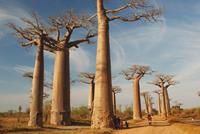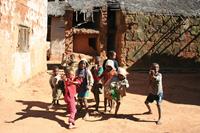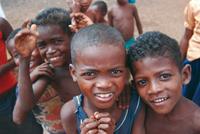 Boabab Trees
Boabab Trees
The Republic of Madagascar is still a raw African travel destination however it is fast becoming popular with those seeking a varied travel experience.
Perhaps made more famous with the younger generation by the series of animated movies, the island Madagascar is an iconic Africa travel destination that deserves more attention from everyone.
The infrastructure is still developing. Yes, there are some 4 and 5 star hotels but they are ridiculously expensive and very out of character of the landscapes and people around them.
Much of the 21 million population are not yet worn out by too much tourism. They are as curious about you – perhaps more –than you are of them. The official language is Malagasy although French speakers will find it much easier to get around thanks to French colonial rule, which ended with Madagascar gaining its independence in 1960. The island still has strong ties with France as well as economic and cultural links with the French-speaking countries of West Africa.
The people are as unique as their land, the Malagasy are an island people, unrelated to the
 Village kids in Madagascar
Village kids in Madagascarpeoples of mainland Africa. They are descended from Indonesian and Malay seafarers who arrived from across the Indian Ocean over 2000 years ago. The Asian origins of the people are evident in the agriculture, seafaring traditions and way of life.
While the island is perhaps more for student expeditions that are looking for greater challenges there is no reason a biology or geography itinerary could not be made for young people that would simply open their mind to a whole new world – well beyond the largely inaccurate scenes which have made it famous on the DreamWorks.
The country is a biologist’s dream destination. Sitting 400 kilometres off the east coast of Africa it offers diverse – and I mean diverse - and spectacular scenery: mountains, deserts, rainforests, beaches and island archipelagos linked by coral reefs and clear turquoise waters.
Madagascar is the fourth largest island on Earth, after Greenland, New Guinea and Borneo. The island, which is 1600km long and almost 600km wide, is a continental fragment of Africa that separated from the continent almost 90 million years ago. This separation has allowed the evolution of a distinctive flora and fauna. It is the home of five percent of the world's plant and animal species, 80 percent of which are unique to Madagascar.
Among its most notable examples of biodiversity are the lemur family of primates, three endemic bird families and its baobab trees. The lemurs of Madagascar are a primitive form of primate that have adapted to many different habitats across the island.
 Children in Madagascar
Children in MadagascarThe island itself is also geologically diverse, with granite and metamorphic rocks making up the central highlands. The west coast is limestone that has been uplifted as tectonic forces slowly tilt the island to the east. This limestone has been eroded in to the distinctive razor-sharp pinnacles of the Tsingy. Elsewhere, the red laterite soils ensure a richly coloured landscape, Madagascar becoming known as the “Great Red Island”.
Madagascar is a large island in mainly tropical latitude; however it can seem both wetter and cooler than expected. Much of Madagascar is highland and during the winter months (May – October) it can get quite chilly and windy at times in the highlands. The coast enjoys a tropical climate and winter offers clear skies and warm conditions. The summer months (Nov – March) can bring the rains to the lowlands, making travel difficult in some areas.
So where to go and what to see and do? Well, the reefs and rainforests are one suggestion.
The northern coast and islands of Madagascar evoke a classical tropical island paradise with white coral beaches, clear blue waters and scent of exotic spices on the breeze. The rainforests are teeming with endemic wildlife and the coral reefs offshore are equally full of life and colour. The north coast and islands of Madagascar are perfect for an active yet relaxing experience. With walks traversing the beaches, headlands and historic fortifications of the craggy coast and then the Lemurs Lakes and waterfalls of the forested hinterland, a deeper connection can be found with the unique Madagascan landscape. A boat journey here can take your group to 'the Scented Island' of Nosy Be, where the fragrances of ylang ylang, frangipani, vanilla and cinnamon drift on the breeze as travellers enjoy snorkelling and other amazing experiences on the vibrant island life.
For lovers of wildlife the Island of Madagascar is synonymous with the exotic, if not the quirky. Isolated from Africa millions of years ago with the breakup of Gondwana, Madagascar has its own unique cargo of endemic plants and animals. Lemurs have filled most mammal ecological niches of the forests and spectacular Chameleons are the most iconic of the reptiles. The climate influences the vegetation from arid Spiny Forest in the south to tropical rainforest in the North and East. A student expedition could be planned around taking in the full diversity of the land and animals, including the Isalo, Andringitra and Ranomafana National Parks, which can all be visited in one itinerary.
At Isalo you can explore lush vegetation in the moist, rugged canyons cut deep into the sandstone plateau which is home to many species of lemur and chameleon. Andringita National Park has a wide diversity of ecosystems ranging from low altitude rainforest in the east to high mountain prairies in the west and the greatest diversity of lemurs in Madagascar. En route to Ranomafana make sure you pass by Ambalavao, with its colourful houses and local craftspeople who manufacture Antaimoro paper from the bark of Ahova trees providing even more astonishing experiences for young people.
Established in 1991, Ranomafana National Park is an area rich in wildlife which has been become a protected area to save the habitat of the rare Golden Bamboo Lemur, the world’s rarest primate. Here, you may catch a glimpse of these fascinating animals as well as some of the other 13 species of lemur only found here.
Other highlights include Kirindy Forest, the only place in Madagascar where one can see fosa (the island’s largest carnivore), striped mongoose and the giant jumping rat as well as the famous baobab alley in western Madagascar, a dirt road lined with the island’s famous trees which has become one of the most visited places on Madagascar.
Perhaps the world’s most diverse destination, travel on Madagascar can be challenging and expensive, but many of the world’s most attractive places often are. Working with the right school expedition provider can help you keep costs down to ensure your dream of taking students to this amazing part of the world can actually become a reality.
Visit the
World Expeditions Schools website to organise your School Adventure to Madagascar.